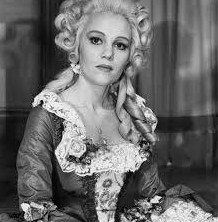During rehearsals for “On the Twentieth Century” in 1978, Madeline Kahn found herself resting backstage when she caught wind of director Harold Prince remarking to someone, “There’s nothing she can’t do—except, maybe, be ordinary.” The observation couldn’t have been more fitting. Earlier that same day, a stagehand had marveled as Kahn exited a scene with her little dog in one hand and a milkshake in the other, only to return moments later and hit a tricky vocal mark with dazzling, comic precision. Here was a performer who wore her talent effortlessly—no ego, just an undeniable spark.
Born in Boston on September 29, 1942, Kahn was raised mostly in New York City. Her mother, Paula, was a trained singer who later worked behind the scenes as a stage manager. Kahn herself attended Hofstra University, where she studied music and drama, nurturing a classically trained soprano voice and dreams of opera stardom. Yet, it was her knack for comedy—her expressive face, impeccable timing, and magnetic presence—that soon drew her toward the stage. Colleagues were amazed at how she could move from the grandeur of Mozart to the zaniness of Mel Brooks without missing a beat.
Her film debut came with 1972’s “What’s Up, Doc?”, where she played an uptight, nasal-voiced fiancée opposite Barbra Streisand and Ryan O’Neal. The performance quickly made her a standout. Mel Brooks, who saw the film, instantly cast her in “Blazing Saddles.” As Lily Von Shtupp, Kahn’s jaded showgirl routine earned her an Oscar nomination for Best Supporting Actress. Brooks later reflected that she captured “that Marlene Dietrich mystique, but with a Brooklyn twist and a sharp wit. Pure magic.”
Her next collaboration with Brooks, “Young Frankenstein,” became even more legendary. Playing the haughty Elizabeth, Kahn turned modest scenes into comic gold with her over-the-top reactions and musical flair. She once shared in an interview that she often improvised, inspired by her co-stars: “If Gene Wilder was going to scream, I figured I might as well swoon as theatrically as possible.” Wilder himself admitted, “She was the only one who could make me break character. Her instincts were simply extraordinary.”
A lesser-known but crucial chapter of her career unfolded on the set of “Paper Moon.” Despite a small role, her performance garnered another Oscar nomination. The shoot was not without friction, however—director Peter Bogdanovich grew frustrated with Kahn’s habit of tweaking lines for extra laughs. She later admitted, “I thought I was helping. He thought I was meddling with his vision.” Their creative tension only reinforced her reputation as an artist who challenged authority when she believed it would elevate the work.
In the late 1980s, Kahn returned to the stage, eventually winning a Tony Award in 1993 for “The Sisters Rosensweig.” By then, her health was already in decline, though she largely kept her struggle private. Even during treatment for ovarian cancer, she continued to work, her spirit undimmed. One of her final roles was on the sitcom “Cosby,” where her warmth and wit shone through despite her pain. Bill Cosby later recalled, “She’d finish a scene, rest, then come back full of energy—as if she’d just had the best vacation. That kind of courage is rare.”
Kahn married John Hansbury in 1999, just two months before her passing on December 3, at the age of 57. Their intimate wedding in Central Park was attended by close friends, one of whom remembered Kahn’s calm resolve: “She told us, ‘I want to laugh through all the tough moments.’ And she did.”
Madeline Kahn thrived on the joy of laughter, the melody of song, and the grace of her own unique self. She elevated every stage and screen she graced, leaving behind a legacy of brilliance, warmth, and unforgettable character.__✍️
